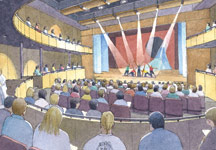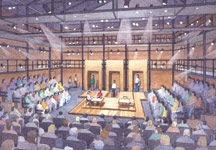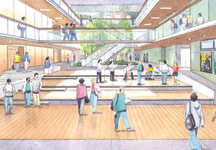
IRIS login | Reed College home Volume 90, No. 2: June 2011
Centennial Campaign
Rhapsody In Brick (continued)

The crowning touch for the performing arts building will be a 450-seat proscenium theatre that will be added when its projected $10 million cost has been raised.

An ideal venue for thesis performances, the 180-seat studio theatre will be equipped with movable seating platforms, catwalks and large acoustical doors that allow the stage to expand into the adjacent scene shop.

The 6,929 square-foot Winter Garden will provide students with space, air, and light for guerrilla theatre, spontaneous jam sessions, impromptu performances, and creative encounters.
Art on the Margins
The performing arts have been an integral part of the Reed experience from almost the beginning. Theatre classes were offered in the art and literature departments before the theatre department was established in 1938. Music history and appreciation classes were part of the curriculum before the music department became a reality in 1947. The P.E. department offered dance classes before the dance department was formed in 1949.
Although more than half of all Reed students take part in the performing arts, the disciplines have been physically marginalized in makeshift quarters spread across eight separate buildings on campus.
The current theatre was built in 1972, using insurance money from a fire that destroyed the old student union. It has virtually no wing space, and a backstage can be created only with curtains. It lacks a catwalk, and the beams that students once crawled along to set the lights were declared unsafe by OSHA (Occupational Safety and Health Administration). Scenery must be built and stored in a warehouse several blocks away. There are no handicap accessible restrooms.
“That run-down, outdated building affirms the secondary status of the theatre department,” says literature/theatre major Dominic Finocchiaro ’11.
Isolated on the southwestern corner of campus, Prexy—built in 1915 as a residence for the college president—houses the music department’s 14 practice rooms. The building has an undeniable charm, with verdant views of the Great Lawn. Practice rooms are not soundproofed, however, and the background cacophony is a real challenge for student musicians. Because of the sound transference, it is necessary to limit percussive instruments, for instance, to certain blocks of time during the week. Denise VanLeuven, director of private music instruction, says she frequently has to request that students play more softly. The old building is in need of constant repairs as well as humidification to protect the instruments.
“Lots of our peer institutions have more robust involvement with the arts than Reed has had,” says professor Morgan Luker [music 2010–], Reed’s first ethnomusicologist, whose position was funded by the Centennial Campaign. “Music has something to say to the rest of the academic community. It’s not a music appreciation model that we’re going for here. It’s about using the arts as a different way of knowing, participating, and engaging.”
With faculty dispersed in two different buildings, the dance department shares facilities with the P.E. department in the sports center.
“To say dance was marginalized is an understatement,” says professor Minh Tran [dance 2008–], one of two half-time dance professors whose positions were also endowed by the campaign. “It’s a gym, it’s not a dance studio. The echo is so bad that when we’re having student discussion, I can’t even hear the students, and they’re only 10 feet from me. I have to scream when I teach. On top of that, we’re competing with a basketball literally smashing against the wall on the other side of a thin dividing wall.”
Existing facilities are a hurdle for students who want to participate in dance, he says.
While the notion of the starving artist is a popular trope, makeshift facilities really don’t contribute much to teaching—or learning.
“The only way to teach the performing arts is to do it,” Diver says. “And if you’re going to have people doing it, you’ve got to have the equivalent of great chemistry labs, which is to say good theatres, great rehearsal spaces, great practice rooms—the whole nine yards.”
A Floorplan for All Seasons
Due for completion in 2013, the new academic facility will bring the three performing arts departments together in a building carved into the slope above the tennis courts on the west side of campus.
“At every corner, this is a teaching facility,” stresses Alec Holser, partner in Opsis Architecture. “Whether it’s a stair landing or a lobby space that works for performance, it’s got to be a place where students come together to learn and connect, to do what Reed students do—get together in small groups and discuss.”
The visual centerpiece of the three-story building will be a 6,929 square-foot atrium Winter Garden that frames the view to the west hills. Extending from the west entrance to the second-level east entrance, it has been designed as a place that will accommodate impromptu jam sessions, guerrilla theatre, and spontaneous gatherings. Outside, an informal amphitheatre is created by a series of terraces descending from the Gray Campus Center quad to the entry plaza.
Professors from the three departments met regularly with the architects and suggested that the “back of the house”—the activities traditionally located behind the theatre—be moved forward so that students could witness the process of creating a performance.
The green room—usually situated backstage—has been brought into the atrium, functioning as a student lounge during the day. A rehearsal room has a glass wall onto the atrium and the 99-seat black box theatre is outfitted with large doors that afford views of rehearsals and set building.
At the north end of the building (now the path between the sports center and Kaul Auditorium) a loading deck will function as another entry. A back stairs will provide quick access to the black box theatre and rehearsal room.
“The whole idea is to make the building a crossroads,” Holser says. “You can move through it in multiple ways, adding points of interaction and connection between people.”
The costume and scene shops on the north wall will benefit from the northern light.
“That’s why the garret studios in Paris had those big, slanted skylights facing north,” Holser says. “Northern light is ideal because it’s constant and doesn’t have the bright shadows. When you’re doing costumes you also have to be able to close those windows off and look at them with stage light. But for day-to-day working, you want it to be light.”
The building will step down from the quad to the west parking lot, a 30-foot difference in elevation, and become Reed’s public portal to the west. It will also complete what is now a three-sided quad, but because of the slope, it will read essentially as a one-story building.
Diver hopes that the building will become an iconic space on campus. “People wrap up a lot of memories in their experience of throwing Frisbees on the quad, sitting on the S.U. porch, hanging out in Old Dorm Block or at the Paradox,” Diver says. “I’m hoping they’ll have similar memories of things they do in the new building.”
Diver is also excited about the building’s large Winter Garden atrium. “The Reed campus doesn’t have enough indoor/outdoor spaces. It has a lot of nice indoor spaces. But this is a climate in which it rains so much that people—particularly during the academic year—can’t hang out outside, unless they’re under cover. One of the reasons the SU porch is so popular is you can hang out there on a 40-degree day. The Winter Garden will be wholly under cover, but it will feel like you’re on a porch, like you’re outdoors.”
In addition to the black box theatre, the building will include a state-of-the-art 180-seat studio theatre (with catwalks!) and a design studio.
The theatre department has as many as 12 students a year doing productions in connection with their theses, says professor Kathleen Worley [theatre 1985–]. The additional performing and rehearsal spaces will make it possible to stage simultaneous events. In addition, technical rehearsals—where sound and lights are set—can occur at the same time students are rehearsing in another space.
The dance department finally gets a dedicated dance studio, divisible by a semi-soundproof wall affording concurrent use by two classes. A wall of south-facing windows lends the two-story space a loft-like feel and showcases student dancers. Another large rehearsal space—outfitted with retractable seating and an overhead lighting grid—will be shared by dance and theatre and can be used as a venue for thesis projects and performances by students, faculty, or visiting artists.
Though the music department will continue to perform in Kaul and the Eliot Hall chapel, it gains a 2,200 square-foot music/choir rehearsal room and soundproofed practice rooms that will replace those at Prexy.
Perhaps the jewel in the crown will be the 450-seat proscenium theatre, which could host major theatre and dance performances. (Big dance productions are currently presented in Kaul Auditorium, although a sprung floor, lighting, and soft goods must be rented for each performance.) It could also be a venue for touring companies, providing students with the valuable experience of taking in professional performances


LATEST COMMENTS
steve-jobs-1976 I knew Steve Jobs when he was on the second floor of Quincy. (Fall...
Utnapishtim - 2 weeks ago
Prof. Mason Drukman [political science 1964–70] This is gold, pure gold. God bless, Prof. Drukman.
puredog - 1 month ago
virginia-davis-1965 Such a good friend & compatriot in the day of Satyricon...
czarchasm - 4 months ago
John Peara Baba 1990 John died of a broken heart from losing his mom and then his...
kodachrome - 7 months ago
Carol Sawyer 1962 Who wrote this obit? I'm writing something about Carol Sawyer...
MsLaurie Pepper - 8 months ago
William W. Wissman MAT 1969 ...and THREE sisters. Sabra, the oldest, Mary, the middle, and...
riclf - 10 months ago